After 10 years without opening a pack, I’m off the wagon
10 years ago, I officially gave up on opening any current-year baseball card product. After more than two years of opening packs, boxes, and cases (probably close to 1,000 packs in all) and getting squat for big hits (Babe Ruth bat cards were barely worth more than a box of cards by the time I finally pulled one), I called it quits and stuck with singles on the secondary market. I never did finish the 2002 Fleer Tradition set…
In May of 2012, my days of not opening a current-year product were over. I had expected this to happen when 2012 Topps Archives was announced, but surprisingly it was 2012 Bowman that did me in. Bowman? A product that I had never bought more than two packs of since it became relevant in 1992 (though that year’s packs yielded a Mariano Rivera RC)? I’m still not sure why this was the product that brought me back, but I have no regrets.
Card Design
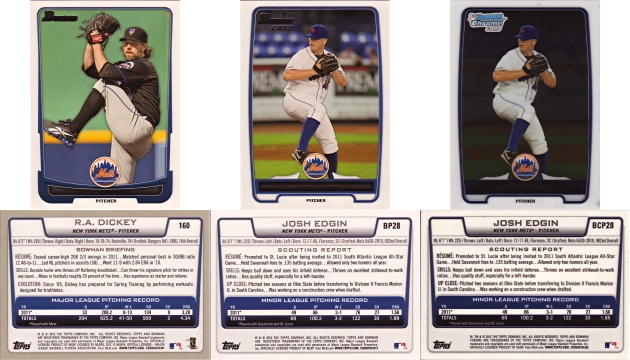
There’s been a lot of praise for this year’s Bowman product, or at least that’s what shows up on the @toppscards Twitter feed (and they couldn’t be biased, right?). Still, at least a few people are raving about it, and for good reason. For the first time since being introduced in 1997, the red-blue-green color coding for stars, first cards, and rookies/prospects is gone, replaced by a simple team-based color stripe around the photo. Topps abandoned a formula? I’m shocked. The result is a classic baseball card look that reminds me a bit of 1990 Fleer (one of the few times Fleer got it right in their 25 year run). Topps also managed to give the base and prospect sets distinct designs that clearly belong together. The design is simple and elegant, a rare but welcome combination. New among the variants this year are ice parallels and wave refractors, both of which are very visually interesting (unlike most previous attempts to jazz up parallels). The ice parallels remind me a bit of 1999 UD HoloGrFX, a great-looking product that was doomed with a terrible follow-up in 2000.
Mets Representation
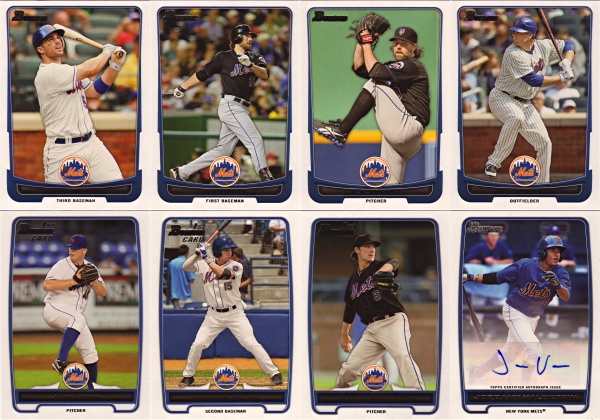
The downside to this product is that it continues the trend of underrepresentation of Mets players in 2012 products. While three Mets made it into the 110-card prospect set (including Spring Training star Josh Edgin) and another three made the 25-card Bowman’s Best prospect set, only four made the cut in the 220-card base set: Wright, Davis, Dickey, and Duda. That puts the Mets somewhere around the bottom quartile of teams by base set representation. It’s better than the Astros (1 card), but do we really need every Yankees starter? Couldn’t someone be bumped for Johan Santana and Daniel Murphy or Ruben Tejada? Topps didn’t even find room for Jason Bay, which is quite unusual. Oh well. Jordany Valdespin (retail autographs white/blue/orange/red) and Brandon Nimmo (Bowman Black autograph) round out the Mets roster. Of note is that Valdespin’s autographs hit retail at about the same time as this game-winning 3-run home run against the Phillies:
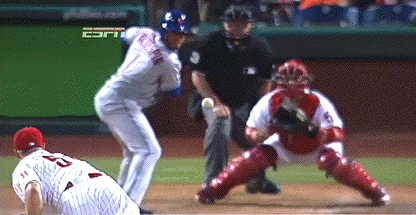
Set Overview
This part is a bit complicated. Inside packs of 2012 Bowman, you’ll find cards from three somewhat distinct products: Bowman, Bowman Chrome, and Bowman’s Best (and their various parallel sets). These were all separate products back when I last bought packs, but the days of downsizing have crammed them all into a single product. That makes sorting out the checklists a bit of a challenge.
Let’s see if we can get this straight. The base Bowman product is 330 cards, with 220 cards in the regular base set and another 110 BP-prefixed prospect cards (with 4 of them misnumbered, oops). The base set has several “RC” designated cards, but only one of them (Cespedes) is also a first Bowman card; the prospect set has lots of cards that are one or the other, but none that are both. Bowman Chrome is exclusively parallel to the 110-card prospect set (with fitting BCP prefixes) and Bowman’s Best is a 50-card insert set with 25 BB-prefixed Bowman’s Best cards and 25 BBP-prefixed Bowman’s Best prospect cards. Did you get all that?
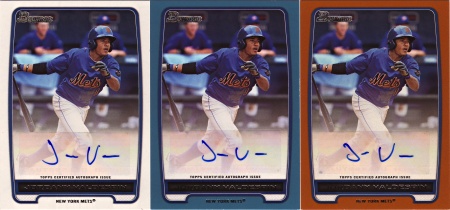
But wait, there’s more! The autographs are even more confusing, with Bowman autographs (all stickers) exclusive to retail packs and Bowman Chrome autographs (all on-card) exclusive to hobby packs. Some of the autos in each are parallels of their respective Bowman/Bowman Chrome cards while others are from players who do not appear in the respective set or players who aren’t anywhere else in the 2012 Bowman product. And then there’s the Bowman Black autographed insert set…
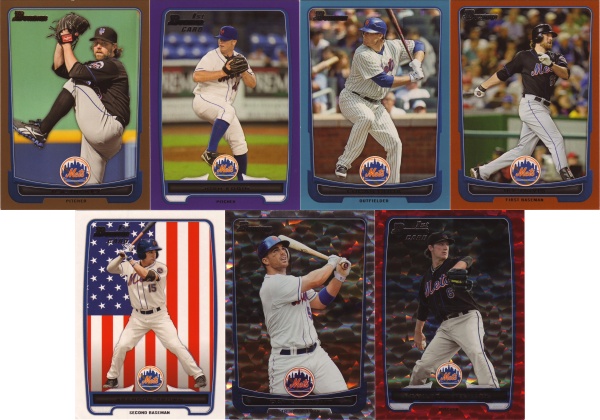
As for the other parallels, well, there are base parallels, chrome parallels, and ice parallels, with some serial numbered, some not, some (gold) only of the 220-card base set, some others (purple, all chromes) only of the 110-card prospect set, and yet others (international, blue, orange, red, ice, red ice) covering all 330 cards; the autographs have similar parallels without any gold, purple, international, or ice/red ice variants (among others). Oh, right, and the Bowman’s Best cards all have die-cut parallels numbered to 99, 25, and 1. Still with me?
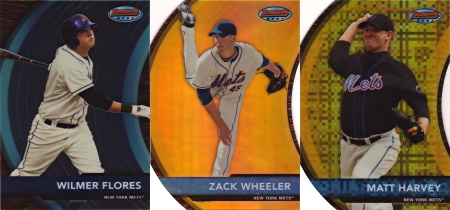 Luckily (or not), you won’t see most of these in a pack. A typical pack will contain one gold parallel card, two Bowman Chrome cards, two prospect cards, and five base cards. Autographs are one per hobby box (and three per jumbo box, not that you can find any). The blue and red wave refractors aren’t in any packs, those are a limited wrapper redemption that I just barely got my wrappers in for before the 10,000 packs were claimed less than a week after the product launched. Like the silver and red ice parallels, the blue and red wave refractors are new parallel styles and look great. It’s nice to see some parallels that aren’t simple color variants or bizarre checkerboard patterns.
Luckily (or not), you won’t see most of these in a pack. A typical pack will contain one gold parallel card, two Bowman Chrome cards, two prospect cards, and five base cards. Autographs are one per hobby box (and three per jumbo box, not that you can find any). The blue and red wave refractors aren’t in any packs, those are a limited wrapper redemption that I just barely got my wrappers in for before the 10,000 packs were claimed less than a week after the product launched. Like the silver and red ice parallels, the blue and red wave refractors are new parallel styles and look great. It’s nice to see some parallels that aren’t simple color variants or bizarre checkerboard patterns.
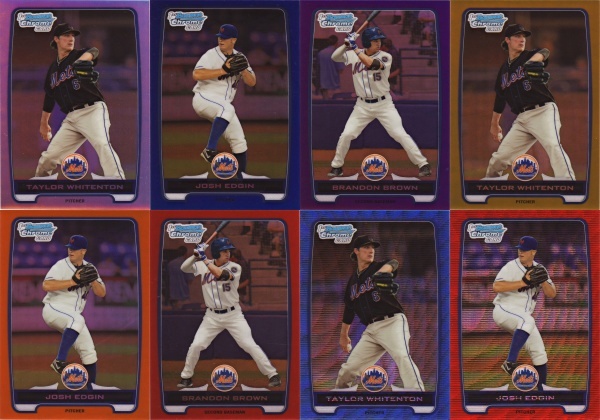
Here’s the breakdown of what I pulled from four boxes, your results may vary:
1 complete 330-card Bowman set (1-220, BP1-BP110) + lots of extras
83/220 of the gold parallel set + 13 extras
12 International parallels
4 Blue parallels (#d/500)
2 Orange parallels (#d/250)
5 Ice parallels
2 Red ice parallels (#d/25)
90/110 of the Bowman Chrome set + 78 extras
3 Refractor parallels (#d/500)
1 Blue refractor parallel (#d/250)
2 Chrome autographs
2 Blue refractor autographs (#d/150)
16 Bowman’s Best cards
And via wrapper redemption:
18 Blue wave refractor parallels
1 Blue wave refractor autograph (#d/50)
1 Red wave refractor parallel (#d/25)
Big hits:
Rookie Davis Blue Wave Refractor Autograph BCP43 37/50
Andrew Susac Blue Refractor Autograph BCP97 142/150
J.T. Wise Red Wave Refractor BCP67 12/25
Justin Nicolino Red Ice Parallel BP1 08/25
As far as value for the money goes, it wasn’t bad. Finishing off the base set was a big plus, but it would have been nice to get the chrome set as well ($5 on eBay fixed that). Two red ice parallels was a big surprise (those are supposed to be about one per case), but those were the only cards numbered to less than 150 straight out of the box (two more came from the wrapper redemption). The one-per-box autographs were nobody special, though getting two blue refractor autos was nice; the best autograph was the Rookie Davis blue wave refractor auto. And one of the base blue parallels was Cespedes, so that was a decent pull (the same box also yielded the base and gold versions as an added bonus; that was much better than the box with gold and ice Shane Victorinos). The biggest Mets hits were a Bowman’s Best Zack Wheeler and gold parallel David Wright, nothing to write home about. The wrapper redemption yielded the biggest pull and accounted for about half of my eBay sales, making the value for future purchases look much poorer. And now on to Archives…
Comments are closed.